Columbanus
Columbanus (Irish: Columbán, 540 – 21 November 615)[1] was an Irish missionary notable for founding a number of monasteries after 590 in the Frankish and Lombard kingdoms, most notably Luxeuil Abbey in present-day France and Bobbio Abbey in present-day Italy.
Saint Columbanus | |
|---|---|
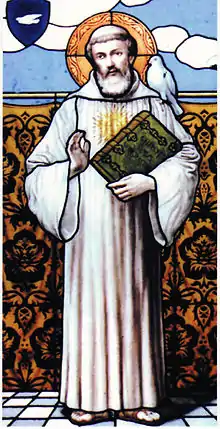 Saint Columbanus, stained glass window, Bobbio Abbey crypt | |
| Born | 540 Leinster, Kingdom of Meath |
| Died | 21 November 615 Bobium, Kingdom of the Lombards |
| Venerated in | Eastern Orthodox Church Roman Catholic Church |
| Feast | 21 November, 23 November |
| Patronage | Motorcyclists |
Columbanus taught an Irish monastic rule and penitential practices for those repenting of sins, which emphasised private confession to a priest, followed by penances levied by the priest in reparation for the sins. Columbanus is one of the earliest identifiable Hiberno-Latin writers.[1]
Sources
Most of what we know about Columbanus is based on Columbanus' own works (as far as they have been preserved)[2][3] and Jonas of Susa's Vita Columbani (Life of Columbanus), which was written between 639 and 641.[Note 1]
Jonas entered Bobbio after Columbanus' death but relied on reports of monks who still knew Columbanus.[1] A description of miracles of Columbanus written by an anonymous monk of Bobbio is of much later date.[4] In the second volume of his Acta Sanctorum O.S.B., Mabillon gives the life in full, together with an appendix on the miracles of Columbanus, written by an anonymous member of the Bobbio community.[1]
Biography
Early life
Columbanus (the Latinised form of Columbán, meaning the white dove) was born near Mount Leinster[5] in the Kingdom of Leinster, now part of Leinster, in Ireland in 540,[1] the year Benedict of Nursia died at Monte Cassino.[6] Prior to his birth, his mother was said to have had visions of bearing a child who, in the judgment of those interpreting the visions, would become a "remarkable genius".[7] Columbanus was well-educated in the areas of grammar, rhetoric, geometry, and the Holy Scriptures.[1][8]
Columbanus left home to study under Sinell, Abbot of Cleenish in Lough Erne.[Note 2] Under Sinell's instruction, Columbanus composed a commentary on the Psalms. He then moved to Bangor Abbey on the coast of Down, where Comgall was serving as the abbot. He stayed at Bangor until his fortieth year,[1] when he received Comgall's permission to travel to the continent.[9][10]
Frankish Gaul

Columbanus gathered twelve companions for his journey—Attala, Columbanus the Younger, Cummain, Domgal (Deicolus), Eogain, Eunan, Gallus, Gurgano, Libran, Lua, Sigisbert, and Waldoleno—and together they set sail for the continent. After a brief stop in Britain, most likely on the Scottish coast, they crossed the channel and landed in Brittany in 585.[1]
At Saint-Malo in Brittany, there is a granite cross bearing Columbanus's name to which people once came to pray for rain in times of drought. The nearby village of Saint-Coulomb commemorates him in name.[11]
Columbanus and his companions were received with favour by King Gontram of Burgundy, and soon they made their way to Annegray, where they founded a monastery in an abandoned Roman fortress. Despite its remote location in the Vosges Mountains, the community became a popular pilgrimage site that attracted so many monastic vocations that two new monasteries had to be formed to accommodate them.[12]
In 590, Columbanus obtained from King Gontram the Gallo-Roman castle called Luxovium in present-day Luxeuil-les-Bains, some eight miles from Annegray.[13] The castle, soon transformed into a monastery, was located in a wild region, thickly covered with pine forests and brushwood. Columbanus erected a third monastery called Ad-fontanas at present-day Fontaine-lès-Luxeuil, named for its numerous springs.[1][13] These monastic communities remained under Columbanus' authority, and their rules of life reflected the Irish tradition in which he had been formed.
As these communities expanded and drew more pilgrims, Columbanus sought greater solitude, spending periods of time in a hermitage and communicating with the monks through an intermediary. Often he would withdraw to a cave seven miles away, with a single companion who acted as messenger between himself and his companions.[1][12][13]
During his twenty years in Gaul (in present-day France), Columbanus became involved in a dispute with the Frankish bishops who may have feared his growing influence. During the first half of the sixth century, the councils of Gaul had given to bishops absolute authority over religious communities. As heirs to the Irish monastic tradition, Columbanus and his monks used the Irish Easter calculation, a version of Bishop Augustalis's 84-year computus for determining the date of Easter (Quartodecimanism), whereas the Franks had adopted the Victorian cycle of 532 years. The bishops objected to the newcomers' continued observance of their own dating, which — among other issues — caused the end of Lent to differ. They also complained about the distinct Irish tonsure.
In 602, the bishops assembled to judge Columbanus, but he did not appear before them as requested. Instead, he sent a letter to the prelates — a strange mixture of freedom, reverence, and charity — admonishing them to hold synods more frequently, and advising them to pay more attention to matters of equal importance to that of the date of Easter. In defence of his following his traditional paschal cycle, he wrote:
I am not the author of this divergence. I came as a poor stranger into these parts for the cause of Christ, Our Saviour. One thing alone I ask of you, holy Fathers, permit me to live in silence in these forests, near the bones of seventeen of my brethren now dead.[6]
When the bishops refused to abandon the matter, Columbanus, following St Patrick's canon, appealed directly to Pope Gregory I. In the third and only surviving letter, he asks "the holy Pope, his Father" to provide "the strong support of his authority" and to render a "verdict of his favour", apologising for "presuming to argue as it were, with him who sits in the chair of Peter, Apostle and Bearer of the Keys". None of the letters were answered, most likely due to the pope's death in 604.[1]
Columbanus then sent a letter to Gregory's successor, Pope Boniface IV, asking him to confirm the tradition of his elders — if it is not contrary to the Faith — so that he and his monks could follow the rites of their ancestors. Before Boniface responded, Columbanus moved outside the jurisdiction of the Frankish bishops. As the Easter issue appears to end around that time, Columbanus may have stopped celebrating Irish date of Easter after moving to Italy.[1][Note 3]
Columbanus was also involved in a dispute with members of the Frankish royal family. Upon the death of King Gontram of Burgundy, the succession passed to his nephew, Childebert II, the son of his brother Sigebert and Sigebert's wife Brunhilda of Austrasia. When Childebert II died, he left two sons, Theuderic II who inherited the Kingdom of Burgundy, and Theudebert II who inherited the Kingdom of Austrasia. As both were minors, Brunhilda, their grandmother, declared herself their guardian and controlled the governments of the two kingdoms.[1]
Theuderic II venerated Columbanus and often visited him, but Columbanus admonished and rebuked him for his behaviour. When Theuderic began living with a mistress, Columbanus objected, earning the displeasure of Brunhilda, who thought a royal marriage would threaten her own power.[12] Columbanus did not spare the demoralised court, and Brunhilda became his bitterest foe.[15] Angered by Columbanus's stance, Brunhilda stirred up the bishops and nobles to find fault with his monastic rules. When Theuderic II finally confronted Columbanus at Luxeuil, ordering him to conform to the country's conventions, Columbanus refused and was then taken prisoner to Besançon.[1]
Columbanus managed to escape his captors and returned to his monastery at Luxeuil. When the king and his grandmother found out, they sent soldiers to drive him back to Ireland by force, separating him from his monks by insisting that only those from Ireland could accompany him into exile.[1]
Columbanus was taken to Nevers, then travelled by boat down the Loire river to the coast. At Tours he visited the tomb of Martin of Tours, and sent a message to Theuderic II indicating that within three years he and his children would perish. When he arrived at Nantes, he wrote a letter before embarkation to his fellow monks at Luxeuil monastery.[1]
The letter urged his brethren to obey Attala, who stayed behind as abbot of the monastic community.[1]
The letter concludes:
They come to tell me the ship is ready. The end of my parchment compels me to finish my letter. Love is not orderly; it is this which has made it confused. Farewell, dear hearts of mine; pray for me that I may live in God.[1]
Soon after the ship set sail from Nantes, a severe storm drove the vessel back ashore. Convinced that his holy passenger caused the tempest, the captain refused further attempts to transport the monk. Columbanus made his way across Gaul to visit King Chlothar II of Neustria at Soissons where he was gladly received. Despite the king's offers to stay in his kingdom, Columbanus left Neustria in 611 for the court of King Theudebert II of Austrasia in the northeastern part of the Kingdom of the Merovingian Franks.[1]
The Alps
Columbanus travelled to Metz, where he received an honourable welcome, and then proceeding to Mainz, where he sailed upwards the Rhine river to the lands of the Suebi and Alemanni in the northern Alps, intending to preach the Gospel to these people. He followed the Rhine river and its tributaries, the Aar and the Limmat, and then on to Lake Zurich. Columbanus chose the village of Tuggen as his initial community, but the work was not successful.[1] He continued north-east by way of Arbon to Bregenz on Lake Constance. Here he found an oratory dedicated to Aurelia of Strasbourg containing three brass images of their tutelary deities. Columbanus commanded Gallus, who knew the local language, to preach to the inhabitants, and many were converted. The three brass images were destroyed, and Columbanus blessed the little church, placing the relics of Aurelia beneath the altar. A monastery was erected, Mehrerau Abbey, and the brethren observed their regular life. Columbanus stayed in Bregenz for about one year.[1] Following an uprising against the community, possibly related to that region being taken over by his old enemy King Theuderic II, Columbanus resolved to cross the Alps into Italy.[1] Gallus remained in this area and died there 646. About seventy years later at the place of Gallus' cell the Monastery of Saint Gall was founded, which in itself was the origin of the city of St. Gallen again about another three hundred years later.
Italy
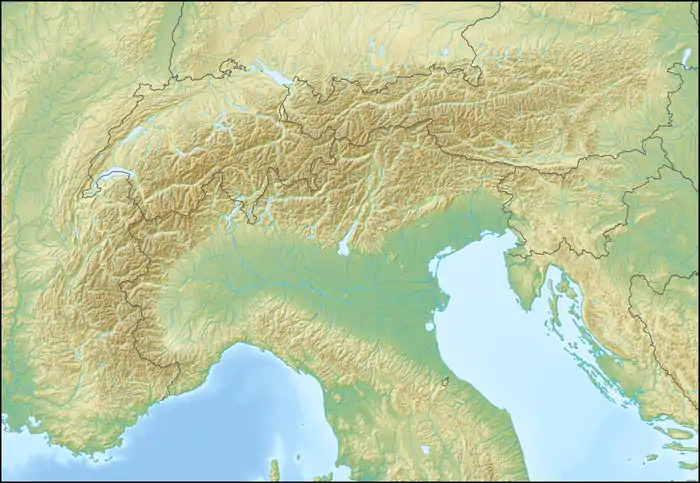
Columbanus arrived in Milan in 612 and was warmly greeted by King Agilulf and Queen Theodelinda of the Lombards.[Note 4] He immediately began refuting the teachings of Arianism, which had enjoyed a degree of acceptance in Italy. He wrote a treatise against Arianism, which has since been lost. Queen Theodelinda, the devout daughter of Duke Garibald I of Bavaria, played an important role in restoring Nicene Christianity to a position of primacy against Arianism, and was largely responsible for the king's conversion to Christianity.[1]
At the king's request, Columbanus wrote a letter to Pope Boniface IV on the controversy over the Three Chapters—writings by Syrian bishops suspected of Nestorianism, which had been condemned in the fifth century as heresy. Pope Gregory I had tolerated in Lombardy those persons who defended the Three Letters, among them King Agilulf. Columbanus agreed to take up the issue on behalf of the king. The letter begins with an apology that a "foolish Scot (Scottus, Irishman)" would be writing for a Lombard king. After acquainting the pope with the imputations brought against him, he entreats the pontiff to prove his orthodoxy and assemble a council. He writes that his freedom of speech is consistent with the custom of his country.[1] Some of the language used in the letter might now be regarded as disrespectful, but in that time, faith and austerity could be more indulgent.[18] At the same time, the letter expresses the most affectionate and impassioned devotion to the Holy See.
We Irish, though dwelling at the far ends of the earth, are all disciples of Saint Peter and Saint Paul ... we are bound to the Chair of Peter, and although Rome is great and renowned, through that Chair alone is she looked on as great and illustrious among us ... On account of the two Apostles of Christ, you are almost celestial, and Rome is the head of the whole world, and of the Churches.
If Columbanus' zeal for orthodoxy caused him to overstep the limits of discretion, his real attitude towards Rome is sufficiently clear, calling the pope "his Lord and Father in Christ", the "Chosen Watchman", and the "First Pastor, set higher than all mortals".[19]
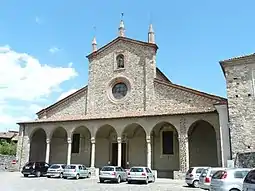
King Agilulf gave Columbanus a tract of land called Bobbio between Milan and Genoa near the Trebbia river, situated in a defile of the Apennine Mountains, to be used as a base for the conversion of the Lombard people. The area contained a ruined church and wastelands known as Ebovium, which had formed part of the lands of the papacy prior to the Lombard invasion. Columbanus wanted this secluded place, for while enthusiastic in the instruction of the Lombards he preferred solitude for his monks and himself. Next to the little church, which was dedicated to Peter the Apostle, Columbanus erected a monastery in 614. Bobbio Abbey at its foundation followed the Rule of Saint Columbanus, based on the monastic practices of Celtic Christianity. For centuries it remained the stronghold of orthodoxy in northern Italy.[1][Note 5]
Death
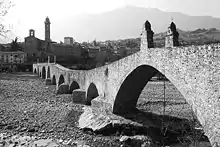
During the last year of his life, Columbanus received messenges from King Chlothar II, inviting him to return to Burgundy, now that his enemies were dead. Columbanus did not return, but requested that the king should always protect his monks at Luxeuil Abbey. He prepared for death by retiring to his cave on the mountainside overlooking the Trebbia river, where, according to a tradition, he had dedicated an oratory to Our Lady.[20] Columbanus died at Bobbio on 21 November 615.
Rule of Saint Columbanus
The Rule of Saint Columbanus embodied the customs of Bangor Abbey and other Irish monasteries. Much shorter than the Rule of Saint Benedict, the Rule of Saint Columbanus consists of ten chapters, on the subjects of obedience, silence, food, poverty, humility, chastity, choir offices, discretion, mortification, and perfection.[21]
In the first chapter, Columbanus introduces the great principle of his Rule: obedience, absolute and unreserved. The words of seniors should always be obeyed, just as "Christ obeyed the Father up to death for us."[21] One manifestation of this obedience was constant hard labour designed to subdue the flesh, exercise the will in daily self-denial, and set an example of industry in cultivation of the soil. The least deviation from the Rule entailed corporal punishment, or a severe form of fasting.[6] In the second chapter, Columbanus instructs that the rule of silence be "carefully observed", since it is written: "But the nurture of righteousness is silence and peace". He also warns, "Justly will they be damned who would not say just things when they could, but preferred to say with garrulous loquacity what is evil ..."[21] In the third chapter, Columbanus instructs, "Let the monks' food be poor and taken in the evening, such as to avoid repletion, and their drink such as to avoid intoxication, so that it may both maintain life and not harm ..."[21] Columbanus continues:
For indeed those who desire eternal rewards must only consider usefulness and use. Use of life must be moderated just as toil must be moderated, since this is true discretion, that the possibility of spiritual progress may be kept with a temperance that punishes the flesh. For if temperance exceeds measure, it will be a vice and not a virtue; for virtue maintains and retains many goods. Therefore we must fast daily, just as we must feed daily; and while we must eat daily, we must gratify the body more poorly and sparingly ..."[21]
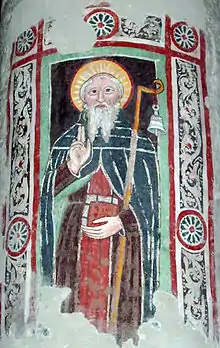
In the fourth chapter, Columbanus presents the virtue of poverty and of overcoming greed, and that monks should be satisfied with "small possessions of utter need, knowing that greed is a leprosy for monks". Columbanus also instructs that "nakedness and disdain of riches are the first perfection of monks, but the second is the purging of vices, the third the most perfect and perpetual love of God and unceasing affection for things divine, which follows on the forgetfulness of earthly things. Since this is so, we have need of few things, according to the word of the Lord, or even of one."[21] In the fifth chapter, Columbanus warns against vanity, reminding the monks of Jesus' warning in Luke 16:15: "You are the ones who justify yourselves in the eyes of others, but God knows your hearts. What people value highly is detestable in God's sight."[21] In the sixth chapter, Columbanus instructs that "a monk's chastity is indeed judged in his thoughts" and warns, "What profit is it if he be virgin in body, if he be not virgin in mind? For God, being Spirit."[21]
In the seventh chapter, Columbanus instituted a service of perpetual prayer, known as laus perennis, by which choir succeeded choir, both day and night.[22] In the eighth chapter, Columbanus stresses the importance of discretion in the lives of monks to avoid "the downfall of some, who beginning without discretion and passing their time without a sobering knowledge, have been unable to complete a praiseworthy life." Monks are instructed to pray to God for to "illumine this way, surrounded on every side by the world's thickest darkness".[21] Columbanus continues:
So discretion has got its name from discerning, for the reason that it discerns in us between good and evil, and also between the moderate and the complete. For from the beginning either class has been divided like light and darkness, that is, good and evil, after evil began through the devil's agency to exist by the corruption of good, but through God's agency Who first illumines and then divides. Thus righteous Abel chose the good, but unrighteous Cain fell upon evil."[21]
In the ninth chapter, Columbanus presents mortification as an essential element in the lives of monks, who are instructed, "Do nothing without counsel." Monks are warned to "beware of a proud independence, and learn true lowliness as they obey without murmuring and hesitation."[21] According to the Rule, there are three components to mortification: "not to disagree in mind, not to speak as one pleases with the tongue, not to go anywhere with complete freedom." This mirrors the words of Jesus, "For I have come down from heaven not to do my will but to do the will of him who sent me." (John 6:38) In the tenth and final chapter, Columbanus regulates forms of penance (often corporal) for offences, and it is here that the Rule of Saint Columbanus differs significantly from that of Saint Benedict.[1]
The Communal Rule of Columbanus required monks to fast every day until None or 3 p.m., this was later relaxed and observed on designated days.[23] Columbanus' Rule regarding diet was very strict. Monks were to eat a limited diet of beans, vegetables, flour mixed with water and small bread of a loaf, taken in the evenings.[23][24]
The habit of the monks consisted of a tunic of undyed wool, over which was worn the cuculla, or cowl, of the same material. A great deal of time was devoted to various kinds of manual labour, not unlike the life in monasteries of other rules. The Rule of Saint Columbanus was approved of by the Fourth Council of Mâcon in 627, but it was superseded at the close of the century by the Rule of Saint Benedict. For several centuries in some of the greater monasteries the two rules were observed conjointly.[1]
Character
Columbanus did not lead a perfect life. According to Jonas and other sources, he could be impetuous and even headstrong, for by nature he was eager, passionate, and dauntless. These qualities were both the source of his power and the cause of his mistakes.[1] His virtues, however, were quite remarkable. Like many saints, he had a great love for God's creatures. Stories claim that as he walked in the woods, it was not uncommon for birds to land on his shoulders to be caressed, or for squirrels to run down from the trees and nestle in the folds of his cowl.[1] Although a strong defender of Irish traditions, he never wavered in showing deep respect for the Holy See as the supreme authority. His influence in Europe was due to the conversions he effected and to the rule that he composed. It may be that the example and success of Columba in Caledonia inspired him to similar exertions.[1] The life of Columbanus stands as the prototype of missionary activity in Europe, followed by such men as Kilian, Vergilius of Salzburg, Donatus of Fiesole, Wilfrid, Willibrord, Suitbert of Kaiserwerdt, Boniface, and Ursicinus of Saint-Ursanne.[1]
Miracles
The following are the principal miracles attributed to his intercession:[1]
- Procuring food for a sick monk and curing the wife of his benefactor
- Escaping injury while surrounded by wolves
- Causing a bear to evacuate a cave at his biddings
- Producing a spring of water near his cave
- Replenishing the Luxeuil granary
- Multiplying bread and beer for his community
- Curing sick monks, who rose from their beds at his request to reap the harvest
- Giving sight to a blind man at Orleans
- Destroying with his breath a cauldron of beer prepared for a pagan festival
- Taming a bear and yoking it to a plough
Jonas relates the occurrence of a miracle during Columbanus' time in Bregenz, when that region was experiencing a period of severe famine.
Although they were without food, they were bold and unterrified in their faith, so that they obtained food from the Lord. After their bodies had been exhausted by three days of fasting, they found so great an abundance of birds, just as the quails formerly covered the camp of the children of Israel, that the whole country near there was filled with birds. The man of God knew that this food had been scattered on the ground for his own safety and that of his brethren, and that the birds had come only because he was there. He ordered his followers first to render grateful praises to the Creator, and then to take the birds as food. And it was a wonderful and stupendous miracle; for the birds were seized according to the father's commands and did not attempt to fly away. The manna of birds remained for three days. On the fourth day, a priest from an adjacent city, warned by divine inspiration, sent a supply of grain to Saint Columban. When the supply of grain arrived, the Omnipotent, who had furnished the winged food to those in want, immediately commanded the phalanxes of birds to depart. We learned this from Eustasius, who was present with the others, under the command of the servant of God. He said that no one of them remembered ever having seen birds of such a kind before; and the food was of so pleasant savor that it surpassed royal viands. Oh, wonderful gift of divine mercy![25]
Legacy

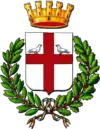
Historian, Alexander O'Hara states Columbanus had a "very strong sense of Irish identity...He’s the first person to write about Irish identity, he’s the first Irish person that we have a body of literary work from, so even on that point of view he’s very important in terms of Irish identity."[26] In 1950 a congress celebrating the 1400 anniversary of his birth took place in Luxeuil, France. It was attended by Robert Schuman, Sean MacBride, future Pope John XXIII and John A. Costello who said "All statesmen of today might well turn their thoughts to St Columban and his teaching. History records that it was by men like him that civilisation was saved in the 6th century."[27][28]
Columbanus is also remembered as the first Irish person to be the subject of a biography. An Italian monk named Jonas of Bobbio wrote a biography of him some 20 years after Columbanus’ death.[29][30] His use of the phrase in 600 AD totius Europae (all of Europe) in a letter to Pope Gregory the Great is the first known use of the expression.[31]
In France, the ruins of Columbanus' first monastery at Annegray are legally protected through the efforts of the Association Internationale des Amis de St Columban, which purchased the site in 1959. The association also owns and protects the site containing the cave, which acted as Columbanus' cell, and the holy well, which he created nearby.[11] At Luxeuil-les-Bains, the Basilica of Saint Peter stands on the site of Columbanus' first church. A statue near the entrance, unveiled in 1947, shows him denouncing the immoral life of King Theuderic II. Formally an abbey church, the basilica contains old monastic buildings, which have been used as a minor seminary since the nineteenth century. It is dedicated to Columbanus and houses a bronze statue of him in its courtyard.[11]
In Lombardy, San Colombano al Lambro in Milan, San Colombano Belmonte in Turin, and San Colombano Certénoli in Genoa all take their names from the saint.[32] The last monastery erected by Columbanus at Bobbio remained for centuries the stronghold of orthodoxy in northern Italy.[1]
If Bobbio Abbey in Italy became a citadel of faith and learning, Luxeuil Abbey in France became the "nursery of saints and apostles".[1] The monastery produced sixty-three apostles who carried his rule, together with the Gospel, into France, Germany, Switzerland, and Italy.[33] These disciples of Columbanus are accredited with founding over one hundred different monasteries.[34] The canton and town still bearing the name of St. Gallen testify to how well one of his disciples succeeded.
The Missionary Society of Saint Columban, founded in 1916, and the Missionary Sisters of St. Columban, founded in 1924, are both dedicated to Columbanus.
Veneration
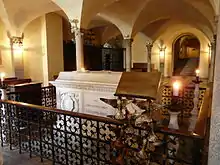
The remains of Columbanus are preserved in the crypt at Bobbio Abbey. Many miracles have been credited to his intercession. In 1482, the relics were placed in a new shrine and laid beneath the altar of the crypt. The sacristy at Bobbio possesses a portion of the skull of Columbanus, his knife, wooden cup, bell, and an ancient water vessel, formerly containing sacred relics and said to have been given to him by Pope Gregory I. According to some authorities, twelve teeth of Columbanus were taken from the tomb in the fifteenth century and kept in the treasury, but these have since disappeared.[35]
Columbanus is named in the Roman Martyrology on 23 November, which is his feast day in Ireland. His feast is observed by the Benedictines on 21 November. Columbanus is the patron saint of motorcyclists. In art, Columbanus is represented bearded bearing the monastic cowl, holding in his hand a book with an Irish satchel, and standing in the midst of wolves. Sometimes he is depicted in the attitude of taming a bear, or with sun-beams over his head.[36]
References
Notes
- Walker's edition is also available on CELT (University College Cork), a website that provides Irish medieval sources with English translations. A critical edition of Jonas's Vita Columbani was published in 1905 by Bruno Krusch in Monumenta Germaniae Historica, Scriptores Rerum Germaincarum in usum schoarum, vol. 37, Hannover: Hahn 1905. See also Internet Medieval Sourcebook.
- Cleenish is derived from the Irish words "Claon Inis", which mean "sloping island". The remains of the monastery can be seen at Bellanaleck, County Fermanagh.
- The Italians themselves followed a third system of reckoning Easter, based on the improvements to Victorius's system introduced by Dionysius Exiguus at the time he devised the Anno Domini dating system.[14]
- Some scholars believe that Columbanus made two journeys into Italy, which were confounded by Jonas. On his first journey, Columbanus went to Rome and received from Pope Gregory I sacred relics.[16] This may possibly explain the traditional spot in St. Peter's, where Pope Gregory I and Columbanus are supposed to have met.[17]
- Bobbio Abbey may have been the model for the monastery in northern Italy in Umberto Eco's novel The Name of the Rose.
Citations
- Edmonds, Columba (1908). "St. Columbanus". The Catholic Encyclopedia. 4. New York: Robert Appleton Company. Retrieved 15 January 2013.
- Walker, G. S. Murdoch, ed. (1957). Columbani Opera. Dublin: The Dublin Institute for Advanced Studies. ISBN 978-1-85500-050-6.
- Lapidge, Michael (1997). Columbanus: Studies on the Latin Writings. Woodbridge: Boydell Press. ISBN 978-0-85115-667-5.
- O'Hara, Alexander, and Faye Taylor. "Aristocratic and Monastic Conflict in Tenth-Century Italy: the Case of Bobbio and the Miracula Sancti Columbani" in Viator. Medieval and Renaissance Studies. 44:3 (2013), pp. 43–61.
- The Story of Columbanus - thecolumbanway.eu
- Smith 2012, p. 201.
- Jonas 643, p. 6.
- Jonas 643, p. 7.
- Wallace 1995, p. 43.
- Jonas 643, p. 10.
- "Columbanus Today: Places of His Ministry". Monastic Ireland. Retrieved 15 January 2013.
- "St. Columbanus". Catholic News Agency. Retrieved 16 January 2013.
- Jonas 643, p. 17.
- Blackburn 1999, p. 767.
- Cusack 2002, p. 173.
- Stokes 2007, p. 132
- Moran 2010, p. 105
- Montalembert 1861, p. 440.
- Allnatt 2007, p. 105.
- Montalembert 1861, p. 444.
- Columbanus Hibernus. Walker, G.S.M. (ed.). "Monk's Rules". Corpus of Electronic Texts. University College Cork. Retrieved 19 January 2013.
- Montalembert 1898, II p. 405.
- Frantzen, Allen J. (2014). Food, Eating and Identity in Early Medieval England. The Boydell Press. p. 184. ISBN 978-1-84383-908-8
- O'Hara, Alexander. (2018). Jonas of Bobbio and the Legacy of Columbanus. Oxford University Press. p. 59. ISBN 978-0-19-085800-1
- Jonas 643, p. 54.
- https://www.irishcatholic.com/europes-forgotten-founding-fathers/
- https://www.irishtimes.com/opinion/columban-the-patron-saint-of-a-united-europe-1.961368
- https://www.irishtimes.com/culture/books/the-first-poem-about-ireland-by-monk-who-inspired-heaney-and-eu-s-architect-1.3013550
- https://www.irishtimes.com/culture/books/the-first-poem-about-ireland-by-monk-who-inspired-heaney-and-eu-s-architect-1.3013550
- https://www.irishtimes.com/opinion/columban-the-patron-saint-of-a-united-europe-1.961368
- https://www.historyireland.com/20th-century-contemporary-history/sidelines-20/
- Webb, Alfred (2009). A Compendium of Irish Biography. Charleston: BiblioLife. ISBN 978-1116472684.
- Stokes, p. 254.
- Stokes, p. 74.
- Stokes, p. 183.
- Husenheth, p. 33.
Bibliography
- Allnatt, Charles F. B. (2007). Cathedra Petri. Whitefish, Montana: Kessinger Publishing. ISBN 978-0548785072.
- Blackburn, Bonnie; Holford-Strevens, Leofranc (1999). The Oxford Companion to the Year. Oxford University Press. ISBN 978-0192142313.
- Concannon, Thomas (2010). The Life of St. Columban. Wimpole Close: BCR. ISBN 978-1117876894.
- Cusack, Margaret Anne (2002). The Illustrated History of Ireland. New York: Gramercy. ISBN 978-0517629147.
- Edmonds, Columba (1908). "St. Columbanus". The Catholic Encyclopedia. 4. New York: Robert Appleton Company. ASIN B000R4GCD8.
- Flechner, Roy; Meeder, Sven, eds. (2016). The Irish in Early Medieval Europe: Identity, Culture and Religion. London: Palgrave Macmillan. ISBN 9781137430595.
- Gray, Patrick T. R., and Michael W. Herren (1994). "Columbanus and the Three Chapters Controversy" in Journal of Theological Studies, NS, 45, pp. 160–170.
- Healy, John (1892). . The ancient Irish church (1 ed.). London: Religious Tract Society. pp. 70–81.
- Jonas (2009). Life of St. Columban. Charleston: BiblioLife. ISBN 978-1113338648.
- Lapidge, Michael, ed (1997). Columbanus: Studies in Latin Writings. London: Boydell Press. ISBN 978-0851156675.CS1 maint: extra text: authors list (link)
- Mc Sweeney, Richard (2015). Abiding in Bobbio. Raleigh, North Carolina: Lulu. ISBN 978-1329382237.
- Montalembert, Charles Forbes (1861). The Monks of the West. 2. London: William Blackwood.
- Moran, Patrick Francis (2010). Irish Saints in Great Britain. Charleston: Nabu Press. ISBN 978-1176742925.
- Ó Fiaich, Tomás (2012). Columbanus in His Own Words. Dublin: Veritas. ISBN 978-1847303578.
- O'Hara, Alexander (2015). Saint Columbanus: Selected Writings. Dublin: Veritas. ISBN 978-1847305879.
- Richter, Michael (2008). Bobbio in the Early Middle Ages: The Abiding Legacy of Columbanus. Dublin: Four Courts Press. ISBN 978-1846821035.
- Smith, Sir William; Wace, Henry (2012). A Dictionary of Christian Biography, Literature, Sects and Doctrines. Charleston: Nabu Press. ISBN 978-1286170847.
- Stokes, Margaret (2007). Six Months in the Apennines. Whitefish, Montana: Kessinger Publishing. ISBN 978-0548271971.
- Wallace, Martin (1995). A Little Book of Celtic Saints. Belfast: Appletree Press. ISBN 978-0862814564.
- Wilson, James (1954). Life of St. Columban. Dublin: Clonmore and Reynolds Ltd. ASIN B0007IWDF0.